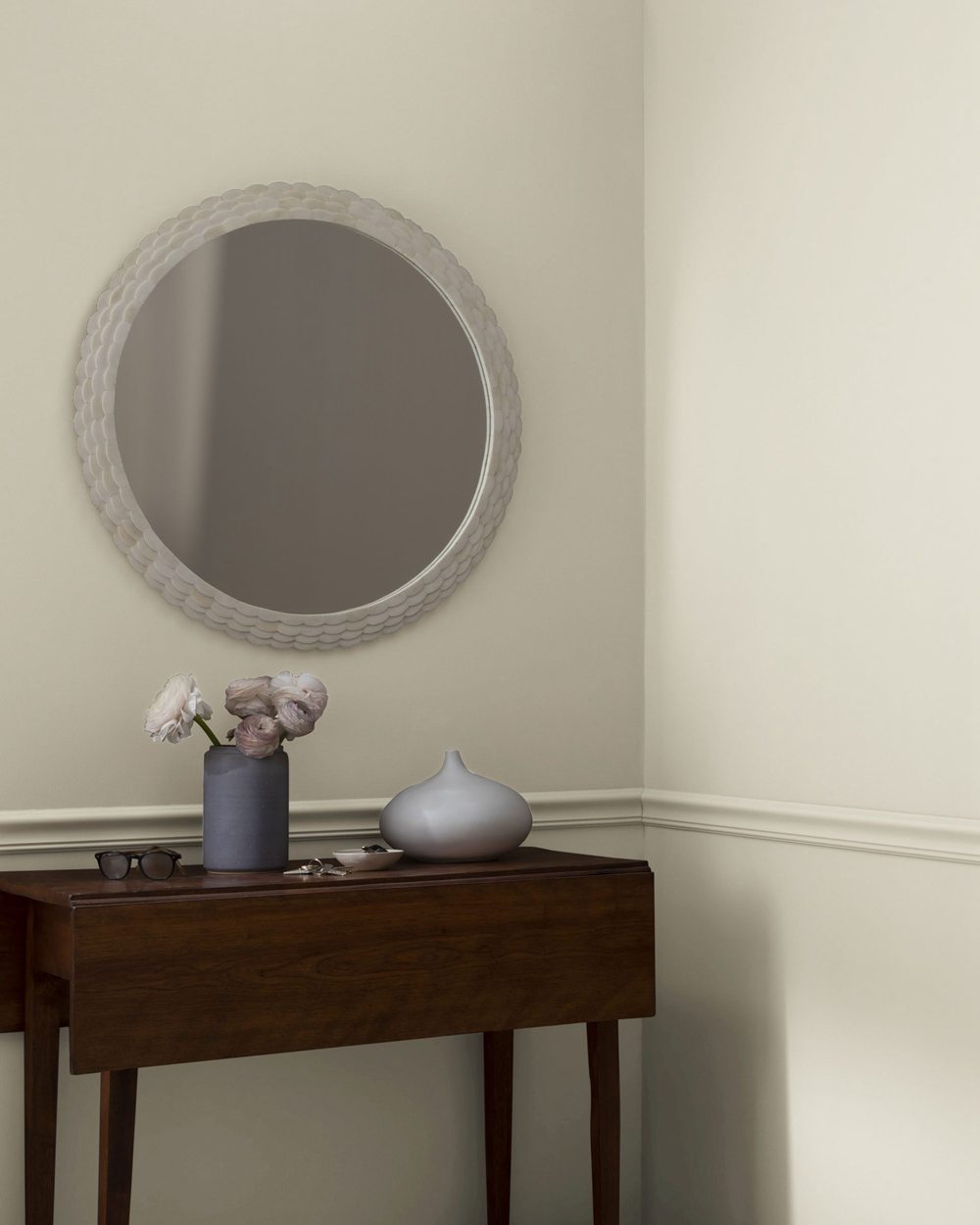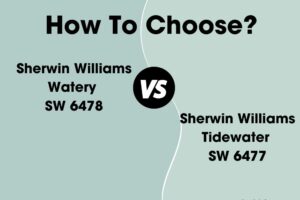Benjamin Moore offers beautiful, versatile off-white paint colors perfect for any home. Two of their most popular are Wind’s Breath OC-24 and Pale Oak OC-20. Both create gorgeous, welcoming backdrops for any space. But what’s the difference between them and how do you choose?
In this guide, we’ll analyze Wind’s Breath and Pale Oak. We’ll compare undertones, light reflectance values (LRV), aesthetics, real-life photos, and best room applications. Read on to determine if cool toned Wind’s Breath or warm Pale Oak is the ideal neutral paint color for your home.
Table of Contents
Key Differences Between Wind’s Breath and Pale Oak
Before diving into specifics, here is an overview of the main differences between Wind’s Breath OC-24 and Pale Oak OC-20:
- Undertones – Wind’s Breath has blue-gray undertones, Pale Oak has yellow-beige undertones
- Light Reflectance – Wind’s Breath has an LRV of 69.59, Pale Oak has an LRV of 68.64
- Use – Wind’s Breath complements modern styles, Pale Oak traditional styles
- Rooms – Wind’s Breath excels in airy spaces, Pale Oak cozier rooms
Now let’s explore Wind’s Breath and Pale Oak more closely.
Benjamin Moore Wind’s Breath OC-24
A gorgeous off-white paint color, Wind’s Breath OC-24 creates an airy, welcoming backdrop for modern interiors. This versatile neutral complements styles from contemporary to bohemian chic.
Here are some details about Benjamin Moore Wind’s Breath:
- LRV: 69.59
- Undertones: Blue-gray
- Finish: Available in all sheens
- Rooms: Whole home, open concept spaces
- Color Pairings: Grays, blues, tans
Featuring delicate blue-gray undertones, Wind’s Breath has an ethereal, barely-there color appearance. Depending on lighting, it can read as a very light gray or take on a hint of blue. This makes it adaptable to various palettes.
With a 69.59 light reflectance value, Wind’s Breath reflects ample illumination to keep open concept spaces feeling airy and bright. The cool undertone gives this gorgeous off-white a relaxed, serene feel.
Wind’s Breath OC-24 works beautifully across many interior design styles, providing the perfect neutral backdrop. Use it to create a sophisticated yet welcoming aesthetic in rooms like:
- Living Rooms
- Dining Rooms
- Kitchens
- Bathrooms
- Open Floor Plan Areas
Some colors that complement Wind’s Breath perfectly include:
- Benjamin Moore Chantilly Lace
- Benjamin Moore Gray Owl
- Benjamin Moore Coventry Gray
- Benjamin Moore Navajo White
Benjamin Moore Pale Oak OC-20
A warm ivory beige neutral, Pale Oak OC-20 creates a welcoming backdrop suitable for a wide range of styles. This versatile color complements designs from farmhouse to modern.
Here are some details about Benjamin Moore Pale Oak:
- LRV: 68.64
- Undertones: Yellow beige
- Finish: Available in all sheens
- Rooms: Living rooms, bedrooms, baths
- Color Pairings: Tans, blues, grays
Featuring soft yellow-beige undertones, Pale Oak shifts between creamy ivory to pale beige depending on lighting. This warmth gives Pale Oak a soothing, welcoming vibe.
At 68.64 light reflectance, Pale Oak reflects ample illumination for most rooms. The subtle beige influence contributes to its soft, gentle feel.
Use Pale Oak OC-20 to create a cozy yet uplifting backdrop. This versatile off-white works beautifully across many home spaces:
- Living Rooms
- Bedrooms
- Kitchens
- Bathrooms
- Dining Rooms
Some colors that pair perfectly with Pale Oak include:
- Benjamin Moore White Dove
- Benjamin Moore Revere Pewter
- Benjamin Moore Gray Owl
- Benjamin Moore Mascarpone
Comparing Wind’s Breath vs Pale Oak
Now that we’ve looked at Wind’s Breath and Pale Oak individually, let’s compare them directly:
Light Reflectance
Wind’s Breath is slightly lighter than Pale Oak, with an LRV of 69.59 vs 68.64. But both reflect ample light to keep rooms openly illuminated.
Undertones
The main difference lies in undertones. Wind’s Breath has cool blue-gray undertones, while Pale Oak has warm yellow-beige.
Use
The coolness of Wind’s Breath complements modern styles, while Pale Oak’s warmth suits traditional designs.
Rooms
Wind’s Breath’s airy brightness suits open kitchens, living areas and baths. Pale Oak’s cozy feel excels in smaller rooms like bedrooms and studies.
Paint Finish
Benjamin Moore offers both Wind’s Breath and Pale Oak in any sheen from matte to high-gloss.
Pairings
Wind’s Breath pairs beautifully with grays, blues and tans. Pale Oak suits colors like brown, cream, white and wood tones.
Wind’s Breath vs Pale Oak Comparison Chart
Here is an overview comparison between Wind’s Breath OC-24 and Pale Oak OC-20:
| Paint Color | Wind’s Breath OC-24 | Pale Oak OC-20 |
|---|---|---|
| LRV | 69.59 | 68.64 |
| Undertones | Blue-gray | Yellow beige |
| Use | Modern, contemporary | Traditional, relaxed |
| Rooms | Open concept spaces | Bedrooms, cozy rooms |
| Sheens | All finishes | All finishes |
| Pairings | Grays, blues, tans | Browns, creams, woods |
Real Life Photos: Wind’s Breath vs Pale Oak
To give a sense of how Wind’s Breath and Pale Oak compare in actual spaces, let’s look at real life photos:
Wind’s Breath OC-24
Pale Oak OC-20
In real spaces, Wind’s Breath appears cooler, crisper, and more airy than the warmer, creamier Pale Oak. But lighting impacts their look. Overall Wind’s Breath reads as more ethereal while Pale Oak feels cozier.
Should I Choose Wind’s Breath or Pale Oak?
So how do you decide between these beautiful Benjamin Moore off-white paint colors? Here are some tips:
Consider Wind’s Breath OC-24 if you want:
- A light ethereal neutral with cool blue undertones
- To brighten and modernize an interior space
- An airy, soothing backdrop for open floor plans
- To coordinate with grays, blues and tans
Consider Pale Oak OC-20 if you want:
- A creamy off-white with subtle yellow tones
- Cozy warmth perfect for small rooms
- To complement farmhouse and traditional styles
- An uplifting neutral suitable for whole home use
To pick, get samples of each neutral and view in your actual space. See how they look at different times of day. Also see how they coordinate with your furnishings, textiles and other design elements.
While both are beautiful off-whites, Wind’s Breath suits modern open plans and Pale Oak traditional cozy spaces. Choose what fits best!
Best Rooms for Wind’s Breath and Pale Oak
Here are rooms that tend to be perfectly suited to Wind’s Breath OC-24 and Pale Oak OC-20:
Wind’s Breath OC-24
- Living Rooms
- Kitchens
- Bathrooms
- Dining Rooms
- Open floor plans
Pale Oak OC-20
- Bedrooms
- Offices
- Dining Rooms
- Living Rooms
- Bathrooms
Of course both can work in any space. But the above applications maximize their unique strengths – the airy openness of Wind’s Breath and cozy warmth of Pale Oak.
Design Ideas Using Wind’s Breath and Pale Oak
On their own, Wind’s Breath and Pale Oak create simple backdrops. Use other paint colors, textures and decor to create complete room designs:
Wind’s Breath Color Pairings
- Benjamin Moore Oxford White (trim/cabinets)
- Benjamin Moore Stormy Sky (accent wall)
- Whitewashed wood furnishing
- Light blue, gray and ivory textiles
Pale Oak Color Pairings
- Benjamin Moore Simply White (trim/ceiling)
- Benjamin Moore Essex Green (accent wall)
- Antique wood furnishings
- Creamy textiles with navy accents
Wind’s Breath vs Pale Oak: Which is Better for Your Home?
Is cooler toned Wind’s Breath or warmer Pale Oak the better Benjamin Moore paint color for your space? It depends on your goals and style:
Consider Wind’s Breath if you want:
- A crisp, airy neutral with light blue undertones
- To brighten and modernize a space
- An ethereal backdrop for open, airy rooms
- A versatile off-white suitable for whole-home use
Consider Pale Oak if you want:
- A creamy off-white with yellow beige warmth
- Cozy, welcoming character for small rooms
- A versatile neutral suitable for traditional homes
- An uplifting neutral with broad appeal
Wind’s Breath shines in open kitchens, living areas and contemporary spaces. Pale Oak excels in cozier bedrooms, dining rooms and traditional homes.
Be sure to get color samples before deciding. Both are stunning versatile neutrals – choose the one that fulfills your goals!
Frequently Asked Questions (FAQ)
Here are answers to some common questions about Wind’s Breath OC-24 and Pale Oak OC-20:
What are the main differences between Wind’s Breath and Pale Oak?
The main differences are their undertones and lightness. Wind’s Breath is cooler and lighter. Pale Oak is warmer and slightly deeper.
Does Wind’s Breath have gray undertones?
Yes, Wind’s Breath has subtle blue-gray undertones. These give it a relaxed, airy feel. The gray influence is very faint.
What colors complement Pale Oak?
Colors like cream, light blue, gray, brown and wood tones complement Pale Oak beautifully. It works well with both warm and slightly cool palettes.
Is Pale Oak suitable for bathrooms?
Definitely. At 68.64 LRV it avoids feeling too dark. And the creamy beige warmth gives bathrooms a welcoming spa-like feel.
Can you use Wind’s Breath on ceilings?
Yes, Wind’s Breath is a gorgeous ceiling color. Its 69.59 LRV reflects plenty of light to avoid darkness. It creates an airy, cloud-like ceiling.


















